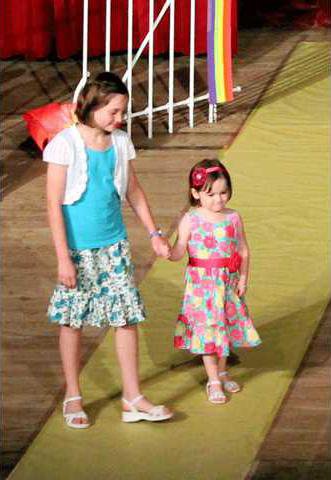The annual 4-H Fashion Revue, leading up to the 2013 Barton County Fair, brought glamour to the catwalk at the Crest Theatre in Great Bend Monday evening. Participants in the buymanship and clothing construction projects were spotlighted as they followed the yellow brick road. Club members modeled outfits they painstakingly built with an eye towards economy, and the garments they constructed with attention to detail and creativity in the weeks and months leading up to the show.
While fashion and flair brought fun to the event, both projects are more about thoughtfulness and consideration, said Barton County extension agents Donna Krug and Bernie Unruh.
“We’d really like kids to think ahead and take into consideration, if they buy or make a $100 dress, how much wear will they get out of it, where will they wear it, and what will the end use be,” Unruh said.
Often, audience members will see participants modeling outfits they find particularly fashionable, and wonder why some are scored higher than others, Unruh said. That’s because there are so many other considerations that go into the judging process behind the scenes the morning before the revue.
At the education wing of Trinity Lutheran Church Monday morning, buymanship and garment construction participants met with judging consultants, modeling their projects, but also turned in a written report about the considerations that went into their choices.
A garment’s value isn’t just determined by how much it cost, Krug said. The cost per wear is important. Judges want to know how much was paid and how many times it will be worn. Some fancy dresses may be worn more than once, or by more than one person if a participant plans to hand it down to a sibling or friends.
“We’re trying to teach them a skill for the future, both in construction and buymanship,” Krug said. “For construction, purchasing fabric can be a pretty pricey prospect these days if it isn’t found on sale. It’s not as simple as it used to be,” Krug said. That may lead to another class of projects next year--the recycled garment.
“It could be as simple as taking something made of denim and adding a ruffle to it, there would be some opportunity for members to add some buymanship skills to their construction,” she said.
Judges take into consideration the skill level of the member taking part in the garment construction project, Unruh said. They also look at the neatness of each of the techniques they use, overall appearance of the garment off and on the child.
“This year we even have some 4-H members that have constructed clothes for younger siblings,” she said.
Krug offered a sewing class earlier in June, and seven girls made skirts they entered as projects. Sidney Cooper and friend Allyson Kaiser took the class together. Cooper modeled the skirt she made in the class.
“I plan to wear it to church and when we go somewhere nice,” she said.
Kaiser entered a quilted table runner she made with her Grandma Joyce, and a sundress she made from fabric they shopped for together.
Aubrey Snapp not only made a skirt for herself, she made a sundress for her little sister, Emma. Both girls modeled the garments together Monday night.
Judges were also on hand to judge fiber arts projects including knitting, crochet, quilting, and needlework of any kind.
“So many kids used to learn from their parents and grandparents, but now so many kids don’t have anyone to teach them.” Krug said. “We try not to let that be a lost art.”
Fiber arts will be on display at the fair. A mini fashion revue is also planned for Thursday evening, July 13 at the Barton County Fair at Expo 2 following the bucket calf show.
Fashionistas of Barton County
4-H FAshion Revue simply stunning, dahling!





